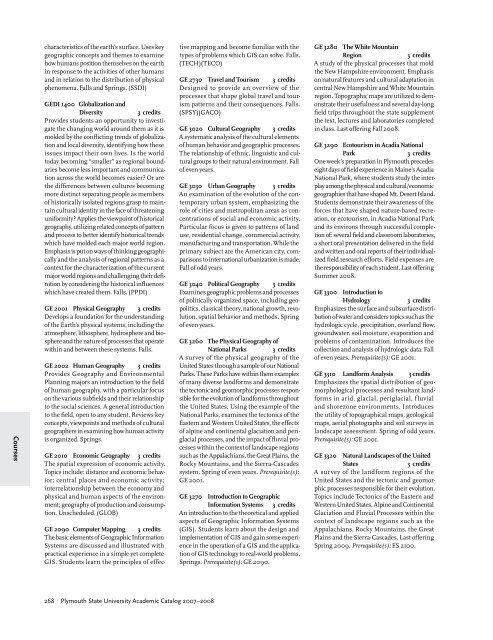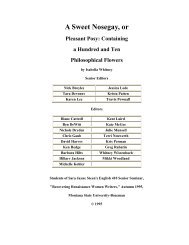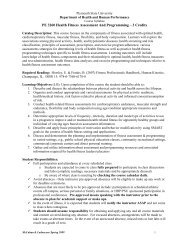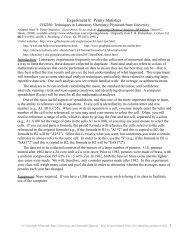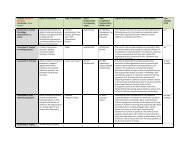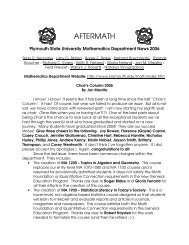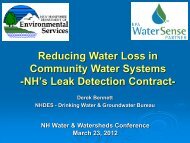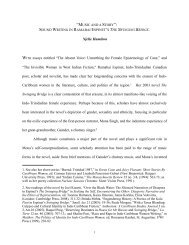2007-2008 Undergraduate Academic Catalog - Plymouth State ...
2007-2008 Undergraduate Academic Catalog - Plymouth State ...
2007-2008 Undergraduate Academic Catalog - Plymouth State ...
- No tags were found...
Create successful ePaper yourself
Turn your PDF publications into a flip-book with our unique Google optimized e-Paper software.
Coursescharacteristics of the earth’s surface. Uses keygeographic concepts and themes to examinehow humans position themselves on the earthin response to the activities of other humansand in relation to the distribution of physicalphenomena. Falls and Springs. (SSDI)GEDI 1400 Globalization andDiversity3 creditsProvides students an opportunity to investigatethe changing world around them as it ismolded by the conflicting trends of globalizationand local diversity, identifying how theseissues impact their own lives. Is the worldtoday becoming “smaller” as regional boundariesbecome less important and communicationacross the world becomes easier? Or arethe differences between cultures becomingmore distinct separating people as membersof historically isolated regions grasp to maintaincultural identity in the face of threateninguniformity? Applies the viewpoint of historicalgeography, utilizing related concepts of patternand process to better identify historical trendswhich have molded each major world region.Emphasis is put on ways of thinking geographicallyand the analysis of regional patterns as acontext for the characterization of the currentmajor world regions and challenging their definitionby considering the historical influenceswhich have created them. Falls. (PPDI)GE 2001 Physical Geography 3 creditsDevelops a foundation for the understandingof the Earth’s physical systems, including theatmosphere, lithosphere, hydrosphere and biosphereand the nature of processes that operatewithin and between these systems. Falls.GE 2002 Human Geography 3 creditsProvides Geography and EnvironmentalPlanning majors an introduction to the fieldof human geography, with a particular focuson the various subfields and their relationshipto the social sciences. A general introductionto the field, open to any student. Reviews keyconcepts, viewpoints and methods of culturalgeographers in examining how human activityis organized. Springs.GE 2010 Economic Geography 3 creditsThe spatial expression of economic activity.Topics include: distance and economic behavior;central places and economic activity;interrelationship between the economy andphysical and human aspects of the environment;geography of production and consumption.Unscheduled. (GLOB)GE 2090 Computer Mapping 3 creditsThe basic elements of Geographic InformationSystems are discussed and illustrated withpractical experience in a simple yet completeGIS. Students learn the principles of effectivemapping and become familiar with thetypes of problems which GIS can solve. Falls.(TECH)(TECO)GE 2730 Travel and Tourism 3 creditsDesigned to provide an overview of theprocesses that shape global travel and tourismpatterns and their consequences. Falls.(SPSY)(GACO)GE 3020 Cultural Geography 3 creditsA systematic analysis of the cultural elementsof human behavior and geographic processes.The relationship of ethnic, linguistic and culturalgroups to their natural environment. Fallof even years.GE 3030 Urban Geography 3 creditsAn examination of the evolution of the contemporaryurban system, emphasizing therole of cities and metropolitan areas as concentrationsof social and economic activity.Particular focus is given to patterns of landuse, residential change, commercial activity,manufacturing and transportation. While theprimary subject are the American city, comparisonsto international urbanization is made.Fall of odd years.GE 3040 Political Geography 3 creditsExamines geographic problems and processesof politically organized space, including geopolitics,classical theory, national growth, revolution,spatial behavior and methods. Springof even years.GE 3260 The Physical Geography ofNational Parks 3 creditsA survey of the physical geography of theUnited <strong>State</strong>s through a sample of our NationalParks. These Parks have within them examplesof many diverse landforms and demonstratethe tectonic and geomorphic processes responsiblefor the evolution of landforms throughoutthe United <strong>State</strong>s. Using the example of theNational Parks, examines the tectonics of theEastern and Western United <strong>State</strong>s, the effectsof alpine and continental glaciation and periglacialprocesses, and the impact of fluvial processeswithin the context of landscape regionssuch as the Appalachians, the Great Plains, theRocky Mountains, and the Sierra-Cascadessystem. Spring of even years. Prerequisite(s):GE 2001.GE 3270 Introduction to GeographicInformation Systems 3 creditsAn introduction to the theoretical and appliedaspects of Geographic Information Systems(GIS). Students learn about the design andimplementation of GIS and gain some experiencein the operation of a GIS and the applicationof GIS technology to real-world problems.Springs. Prerequisite(s): GE 2090.GE 3280 The White MountainRegion3 creditsA study of the physical processes that moldthe New Hampshire environment. Emphasison natural features and cultural adaptation incentral New Hampshire and White Mountainregion. Topographic maps are utilized to demonstratetheir usefulness and several day-longfield trips throughout the state supplementthe text, lectures and laboratories completedin class. Last offering Fall <strong>2008</strong>.GE 3290 Ecotourism in Acadia NationalPark3 creditsOne week’s preparation in <strong>Plymouth</strong> precedeseight days of field experience in Maine’s AcadiaNational Park, where students study the interplayamong the physical and cultural/economicgeographies that have shaped Mt. Desert Island.Students demonstrate their awareness of theforces that have shaped nature-based recreation,or ecotourism, in Acadia National Parkand its environs through successful completionof: several field and classroom laboratories,a short oral presentation delivered in the fieldand written and oral reports of their individualizedfield research efforts. Field expenses arethe responsibility of each student. Last offeringSummer <strong>2008</strong>.GE 3300 Introduction toHydrology3 creditsEmphasizes the surface and subsurface distributionof water and considers topics such as thehydrologic cycle, precipitation, overland flow,groundwater, soil moisture, evaporation andproblems of contamination. Introduces thecollection and analysis of hydrologic data. Fallof even years. Prerequisite(s): GE 2001.GE 3310 Landform Analysis 3 creditsEmphasizes the spatial distribution of geomorphologicalprocesses and resultant landformsin arid, glacial, periglacial, fluvialand shorezone environments. Introducesthe utility of topographical maps, geologicalmaps, aerial photographs and soil surveys inlandscape assessment. Spring of odd years.Prerequisite(s): GE 2001.GE 3320 Natural Landscapes of the United<strong>State</strong>s3 creditsA survey of the landform regions of theUnited <strong>State</strong>s and the tectonic and geomorphicprocesses responsible for their evolution.Topics include Tectonics of the Eastern andWestern United <strong>State</strong>s, Alpine and ContinentalGlaciation and Fluvial Processes within thecontext of landscape regions such as theAppalachians, Rocky Mountains, the GreatPlains and the Sierra-Cascades. Last offeringSpring 2009. Prerequisite(s): ES 2100.268 <strong>Plymouth</strong> <strong>State</strong> University <strong>Academic</strong> <strong>Catalog</strong> <strong>2007</strong>–<strong>2008</strong>


